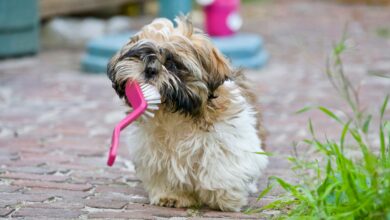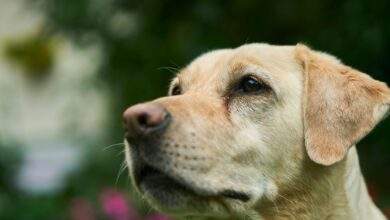
As a loving pet owner, you’re probably well-acquainted with the never-ending battle against pet hair. Dealing with shedding is a natural occurrence in dogs and cats, but it doesn’t mean you have to surrender your home to a sea of fur. In this comprehensive guide, we’ll explore effective strategies for dealing with shedding and maintaining a hair-free and clean living environment for both you and your beloved furry companion.
Table of contents
Understanding Pet Shedding
Before we delve into the art of managing pet hair, it’s important to grasp why your pets shed:
- Seasonal Changes: Many pets shed their old fur to make room for a new coat as the seasons shift. This adaptation helps them regulate their body temperature.
- Breed Factors: Certain breeds are more prone to shedding due to their specific coat types. Some are blessed with thick, double coats that tend to shed more.
- Health and Diet: The overall health and diet of your pet play a significant role in the amount of shedding they experience. Poor nutrition can lead to excessive shedding, as can underlying health issues.
- Stress and Anxiety: Pets under stress or experiencing anxiety may also shed more. It’s their body’s response to emotional turmoil.
Now that we understand the “why” behind pet shedding, let’s explore effective strategies for managing this natural phenomenon.
Strategies for Managing Pet Hair
1. Regular Brushing
Why: Brushing your pet helps remove loose fur, reducing the amount of hair that ends up on your floors, furniture, and clothing.
How:
- Select the Right Brush: Invest in a brush specifically designed for your pet’s coat type.
- Brush Regularly: Establishing a consistent brushing routine is key to managing shedding.
- Outdoors Preferred: Whenever possible, brush your pet outdoors to prevent loose hair from infiltrating your indoor spaces.
2. High-Quality Diet
Why: Proper nutrition plays a pivotal role in reducing shedding.
How:
- Consult Your Vet: Talk to your veterinarian about your pet’s diet to ensure it meets their specific nutritional needs.
- Omega-3 Fatty Acids: Consider adding supplements rich in omega-3 fatty acids to your pet’s diet, as these can contribute to healthier skin and fur.
3. Bathing and Grooming
Why: Regular baths and grooming sessions are effective ways to remove loose hair.
How:
- Bath Time: Use pet-specific shampoo and conditioner to maintain your pet’s skin and coat health.
- Professional Grooming: For breeds with heavy shedding, consider periodic visits to a professional groomer.
4. Pet Hair-Friendly Furniture
Why: Selecting furniture that resists pet hair accumulation simplifies the cleanup process.
How:
- Choose the Right Fabrics: Opt for furniture materials such as leather or microfiber that naturally repel pet hair.
- Use Furniture Covers: Employ washable covers to safeguard your furniture from pet hair.
5. Vacuuming and Cleaning
Why: Regular cleaning is essential for managing pet hair.
How:
- Invest in a High-Quality Vacuum: Choose a vacuum cleaner equipped with strong suction power and a HEPA filter to effectively capture pet hair.
- Clean Carpets and Upholstery: Employ pet hair-specific attachments to remove hair from soft surfaces like carpets and upholstery.
6. Laundry Care
Why: Don’t neglect pet hair on your clothing and linens.
How:
- Lint Rollers: Keep lint rollers readily available for swift hair removal from clothing.
- Dryer Tricks: Utilize your dryer by adding a dryer sheet to the load, which can help release trapped pet hair.
7. Pet Hair Removal Tools
Why: Specialized tools can make pet hair removal more efficient.
How:
- Lint Brushes: Lint brushes or pet hair rollers are great for tackling clothing and furniture.
- Rubber Gloves: Don a pair of rubber gloves and glide them over fabric surfaces to easily collect pet hair.
8. Manage Shedding Season
Why: Shedding tends to intensify during specific times of the year.
How:
- Increase Brushing: During shedding season, amp up your brushing routine to stay ahead of excessive hair.
- Consult a Vet: If your pet’s shedding appears unusually excessive, consult your veterinarian to rule out any underlying health concerns.
9. Create Pet-Free Zones
Why: Designating pet-free zones within your home ensures that some areas remain free of pet hair.
How:
- Use Baby Gates: Block off specific rooms or areas where pets are not allowed.
- Designated Pet Beds: Train your pets to use designated beds or blankets to confine their hair to those areas.
10. Air Purifiers
Why: Air purifiers can help remove pet hair and dander from the atmosphere.
How:
- Select the Right Model: Choose an air purifier equipped with a HEPA filter, specifically designed for pet owners.
- Proper Placement: Position the air purifier in areas where your pet spends the most time to maximize its effectiveness.
Managing Pet Hair on Clothing
1. Use a Clothes Brush or Lint Roller
Why: These tools are incredibly effective at quickly removing pet hair from clothing.
How:
- Brush or Roll: Gently brush or roll the tool over your clothing to pick up pet hair.
- Travel-Friendly: Keep a lint roller in your car or bag for on-the-go pet hair emergencies.
2. Dryer Sheets
Why: Dryer sheets can help loosen and release pet hair from clothing.
How:
- Toss in the Dryer: Add a dryer sheet to the dryer with your pet-hair-covered clothing.
- Use During Laundry: Place a dryer sheet in the washer when cleaning pet hair-covered linens and clothing.
3. Rubber Gloves
Why: Rubber gloves are an excellent, budget-friendly tool for pet hair removal.
How:
- Dampen and Rub: Dampen the gloves and rub them over the clothing to collect pet hair.
- Reuse: Rinse the gloves to remove the collected hair and use them again.
Managing Pet Hair in the Car
1. Use Seat Covers
Why: Protect your car seats with washable seat covers.
How:
- Cover Up: Install washable seat covers on your car seats to shield them from pet hair.
- Regular Cleaning: Remove and wash seat covers regularly to keep them free from accumulated hair.
2. Vacuum Regularly
Why: A portable car vacuum cleaner can help you maintain a hair-free car interior.
How:
- Portable Vacuum: Invest in a portable car vacuum cleaner designed for pet hair removal.
- Frequent Cleaning: Make vacuuming your car’s interior a regular habit to prevent hair buildup.
Dealing with Pet Hair Allergies
If you or someone in your household has pet hair allergies, consider these additional steps:
- HEPA Air Purifiers: Invest in HEPA air purifiers to reduce airborne allergens.
- Allergy-Resistant Bedding: Use hypoallergenic mattress and pillow covers.
- Frequent Cleaning: Regularly clean and vacuum your home to minimize allergen buildup.
Dealing with Shedding
Dealing with shedding doesn’t have to be a constant struggle. By implementing these strategies and incorporating regular grooming into your pet’s routine, you can keep your home cleaner and more comfortable for both you and your furry friend. Shedding is a natural part of pet ownership, but with the right approach, you can manage it effectively.








